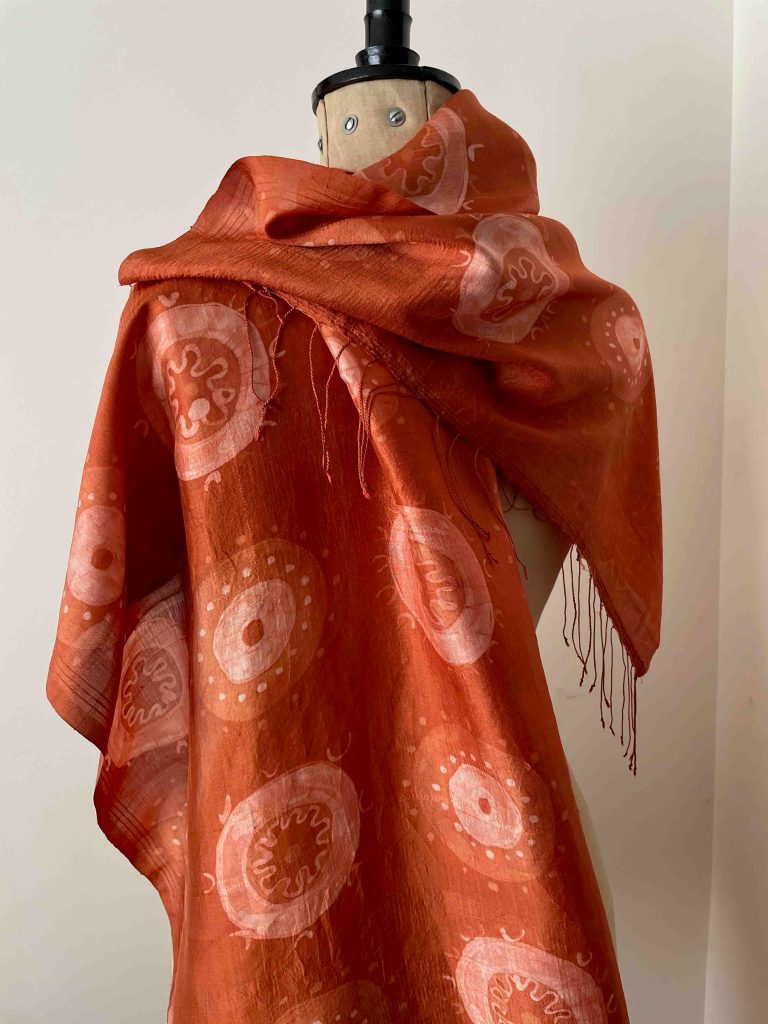I have been trying to find a more satisfying source of silk than commercial, sparkling white, smooth and ‘perfect’ cloth imported from China. Since last autumn I have been working on mulberry silk, a handwoven ‘heritage’ cloth from India whose export and sale is supporting handweavers in West Bengal. Its natural colour is a pale creamy yellow. Slubs and weave imperfections in the shawls I have chosen are part of their intrinsic beauty.
I mordant the scarves in alum and cream of tartar (unless I’m only dyeing with indigo) and I either dye a pale base or start from the natural silk colour. The wax and dye is worked in layers, with each layer and colour building up a pattern as I block areas out with wax. The designs are loosely based on forms of virus – which are helpful and unhelpful to the human race – and frequently look very pretty through a microscope.

Despite the technique being slow and methodical it isn’t without hazards, mostly due to my senior lapses in concentration. I have overheated the dye vessel (the wax melted); I’ve placed a pattern motif in the wrong place, and I’ve left a small piece of masking tape on the cloth, which efficiently resisted the indigo and left a mark. Because the shawls are expensive I feel very upset when I mess one of them up, but minor wobbles or mistakes reflect the handwoven beauty of the scarves themselves, so I try to be philosophical about it. The cloth is full of slubs, and often shows an uneven density of warp threads which affect the dye take-up. More fibre takes up more dye, so the cloth can have variations in colour. They are utterly fiendish to photograph as they are very lustrous and the colour appears to change all the time.
Shawl below dyed in walnut leaf and indigo

Wax on base layer of straw yellow 
A weak indigo vat was used to dye a very pale blue on the yellow 
A stronger blue vat was used at layer 4 
Layer 4 detail 
Layer 5 also showing a dipped border, using a stronger indigo vat
Details of the forthcoming Spring Show at the Devon Guild of Craftsmen here

May 14, 2021 at 12:46 pm
Hi Isabella,
This so so beautiful- Thanks for sharing your work and process- the ups and downs! – with us ..
What dyes work well with this cooler
Dyeing process?
Thank you!
judy
May 14, 2021 at 2:24 pm
Thank you, Judy. So far I’ve tried madder, weld, walnut leaf and indigo. All have worked well but I found the madder dyed really slowly. That’s when I decided I needed to increase the mordant percentage.
May 14, 2021 at 1:09 pm
This is really beautiful work, Isabella. What kind of wax do you prefer to use?
May 14, 2021 at 2:12 pm
Thank you, Mel. I use a blend of beeswax and paraffin wax. The shawls are very large and I don’t really have a vessel large enough for them to circulate without my cracking the wax, so I may go to all-beeswax as it’s more pliable and forgiving of being swooshed around. But then the highest ‘safe’ temperature for the dye pot will have to go down so I don’t melt it…..!!
May 14, 2021 at 3:00 pm
Stunningly beautiful…clever you. Xx
Sent from my iPad
>
May 14, 2021 at 3:41 pm
Thank you so much.
May 14, 2021 at 3:39 pm
How lovely to see you are still fond of circles with patterns. Brings me right back to your work from the time you lived in Oxfordshire. I like the texture of the mulberry silk and to me it goes so well with the natural dyes. Nature is not perfect so why should we or our work be. The older I get the more I like imperfection 😉
Wish I could go and see your work at the exhibition.
May 14, 2021 at 3:42 pm
Thank you, Marianne. It’s lovely to hear from you again
January 4, 2023 at 12:41 am
This waas great to read